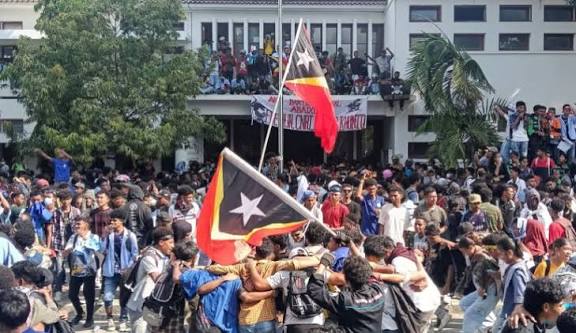Across Asia, a new wave of protests has erupted, challenging governments from Nepal to Indonesia, Bangladesh, and Timor-Leste. Although the triggers differ—from corruption scandals to social media bans and economic grievances—the underlying story is the same: young people, students, and workers are demanding accountability, transparency, and fairness in political governance.
This movement, often called Asia’s Gen Z uprising, is reshaping the democratic landscape of the region. Its implications reach beyond local politics—it raises questions about how digital freedom, economic justice, and government legitimacy will shape Asia’s future.
Nepal: Social Media Ban Sparks National Uprising
Nepal has seen one of the most dramatic turns. In early September 2025, Prime Minister K.P. Sharma Oli’s government banned several social media platforms—Facebook, Instagram, X (formerly Twitter)—in an attempt to quell growing dissent over corruption and economic stagnation.
The decision backfired instantly. Students, activists, and ordinary citizens flooded the streets, calling the ban an attack on free speech and a diversion from rampant unemployment, rising costs, and government mismanagement.
The protests escalated quickly—government buildings and even the parliament were set on fire. Reports estimate dozens killed and hundreds injured as clashes broke out with security forces.
By September 9, Oli resigned, the ban was lifted, and an interim government was appointed. But the scars remain. For many, the protests symbolized a turning point in how Nepali citizens—particularly the youth—perceive their government’s legitimacy.
Indonesia: Economic Strains Fuel Discontent
Indonesia’s protests followed a different trigger but carried a similar undercurrent of anger. In late August and September 2025, students, gig workers, and civil society groups took to the streets to protest rising living costs, unemployment, and revelations of lawmakers enjoying excessive perks and allowances.
The optics of politicians enjoying luxury while ordinary Indonesians face economic hardship were impossible to ignore. Demonstrators clashed with police in Jakarta and other cities, and the protests spread across multiple sectors—from labor unions to online workers.
The government responded with mixed signals: small concessions to appease the crowds, but also police crackdowns that drew criticism from human rights groups. For now, the protests remain ongoing, and the demands are widening—from economic reforms to broader calls for transparency and accountability.

Bangladesh: Student-Led Revolt Against Corruption
Bangladesh has been no stranger to student activism. In recent years, protests have erupted against corruption in education, wage stagnation, and electoral manipulation. In 2025, these movements intensified, linking grievances over inequality with growing suspicion of foreign interference in the country’s politics.
Students spearheaded nationwide protests that often turned violent, with universities and transport systems disrupted. Critics argue the government underestimated the generational anger, while others warn that continued unrest could undermine Bangladesh’s hard-won economic progress in garments and exports.
Timor-Leste: Small Nation, Loud Voices
In Timor-Leste, protests may have seemed small compared to Nepal or Indonesia, but their symbolism was powerful. Students and activists condemned parliament’s decision to purchase expensive SUVs for lawmakers while poverty rates remain among the highest in Asia.
In response, parliament canceled the purchase and began debating reforms to abolish lifetime pensions for former MPs—a rare instance where protest directly forced governance change. This episode highlights how even small nations are part of the wider democratic push sweeping across the continent.
Shared DNA of Asia’s Protest Movements
Looking across these uprisings, a few unifying themes stand out:
- Economic Frustration: Inflation, unemployment, and inequality provide the backdrop for nearly all protests. People are less willing to tolerate government excess when daily life grows harder.
- Digital Mobilization: Social media remains the beating heart of Gen Z activism. Attempts to restrict it—like in Nepal—only backfire, turning platforms into symbols of resistance.
- Symbolic Triggers: The spark is often symbolic—luxury cars, political perks, censorship—not necessarily large-scale policy shifts. These triggers channel deeper resentment into action.
- Generational Leadership: From Kathmandu to Jakarta, it is overwhelmingly young people driving these protests. This generational divide could reshape politics for decades.
- Diverse Outcomes: While Timor-Leste saw immediate reforms, Nepal experienced government collapse, and Indonesia faces an ongoing struggle. The trajectory of each movement depends on the state’s willingness to reform and the protesters’ ability to sustain pressure.
Implications for Democracy & Diplomacy
These protest waves are not just domestic stories, they matter globally:
- Democracy Under Pressure: Governments in Asia’s fragile democracies are being forced to reckon with the reality that legitimacy depends on accountability.
- Authoritarian Temptations: Some regimes may see suppression as easier than reform, risking cycles of crackdowns and more intense dissent.
- Foreign Interference Claims: From Bangladesh to Nepal, accusations of meddling—by major powers like India, China, or Western states—have become part of the narrative.
- Regional Solidarity: Activists across borders watch and learn from each other, creating a shared culture of protest in Asia.
What Comes Next?
The next phase of Asia’s protest wave depends on how governments respond. If leaders embrace reform, listen to youth, and prioritize transparency, protests could lead to democratic strengthening. But if repression wins the day, Asia risks spiraling into cycles of unrest and instability.
One thing is certain: the youth of Asia are not staying silent. In the words of a Nepali protest leader posted on X: “We are the generation that grew up with the internet—we know the world, and we know when we’re being lied to.”

